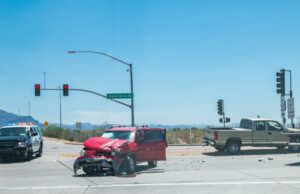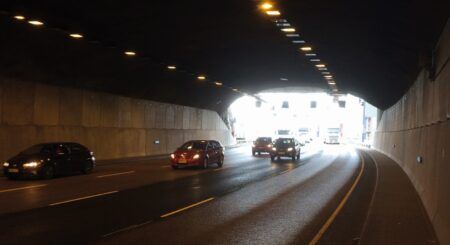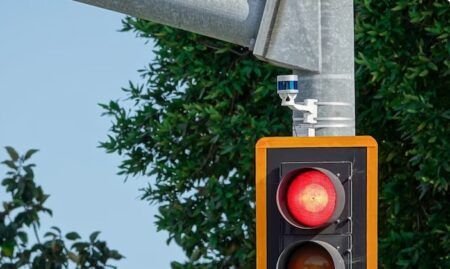At the ITS World Congress in Dubai this week (September 16-20) Swarco is showcasing how red-light protection technology can help reduce the increasing number of drivers running red lights, and so improve safety for drivers and pedestrians. This feature investigates the technology – to find out more visit Swarco at Booth H8-G12.
Red-light running is on the rise in the US and impacting the safety of our roadways and road users. Drivers are going further than just missing the signal change from yellow to red at traffic intersections. Drivers are intentionally running red lights, even when they have enough time and distance to stop safely. To make matters worse, this driving behavior and attitude toward others on the roads, and the laws designed to protect them, also manifests itself at stop signs and when drivers should yield to others in the traffic flow.
Intentional red-light running puts everyone at risk – drivers and pedestrians alike. A recent study by the Insurance Institute for Highway Safety in the US showed that a red-light violation happened approximately once every 20 minutes. In 2021, 1,109 people were killed in the US in crashes involving red-light running, up from 846 deaths in 2019, according to the American Automobile Association (AAA). Driver behavior is getting worse, not better.
So, who is at fault? We all share the responsibility and duty to drive in a way that protects everyone on the road. Given that, what is the solution? The first solution is for all of us to drive responsibly. The remaining options are compliance and law based. However, drivers seem less concerned with abiding by laws and the penalties associated with breaking them.
Additionally, a recent study Road Safety Behaviours: Role of Control Beliefs and Risk Perception1 highlighted the dangers associated with our inability to assess risk while driving. The study points out that many drivers have a false sense of control and safety and make dangerous driving decisions based on this false perception. This lack of perception fuels dangerous driving behaviors, such as speeding when road conditions dictate slower speeds, including when rain is present.
Traffic intersection red-light protection saves lives and protects all at the intersection, not just the red-light runner
Pandemic impact
So why has dangerous driving and red-light running worsened in the past five years? The simple answer may be a result of the pandemic. There is a direct correlation between the timing of the pandemic and an increase in traffic fatalities. The change in driving behavior is widely believed to be a result of the damaging effects of the pandemic and regulations limiting citizens’ movements and mobility. Less traffic, increased speeds, and a reduction in law enforcement led to aggressive driving behaviors that have remained.
While industry solutions exist to counter red-light running, they are not implemented at all intersections. Unfortunately, many intersections that do have the technology in place, do not have the technology enabled or configured correctly.
One solution is dilemma zone warnings, which can reduce the possibility of a driver running a red light. However, this only works for a single driver and doesn’t protect all those at an intersection when a driver accidentally or purposefully runs a red light. Another solution is red-light cameras. While initially effective, these systems are expensive, and only a limited number of states in the US have laws allowing them.

Red-light protection benefits
Red-light protection is the standout solution. It is low-cost and can be applied throughout an entire traffic signal system. Typically, red-light protection is embedded in the traffic system controller software.
While multiple red-light protection offerings are available, the best solution protects the intersection from a red-light runner, not the driver from running a red light. While this seems obvious, not all solutions approach the dangers of red-light running in this manner.
A well-designed, effective red-light protection solution must provide maximum safety benefits while satisfying agency requirements and have the following features and functionality: provide a user-programmed red protection period for any potential red-light runner; provide a limit to the number of red-light number of red-light runner activations per cycle or per time period (headway) to maintain coordination; work while in coordination or free modes; provide alerts and alarms while logging all activations in both high-resolution data logs and controller logs; predict the red-light running event, and be detector and detection technology agnostic.
Additionally, an effective solution should also protect all users of the intersection, not just the red-light violator. It shouldn’t be a constant red clearance interval that drivers can learn, and it shouldn’t teach drivers bad behavior. The solution should also be inexpensive and easily added to any existing intersection with proper detection and qualify for funding as a safety enhancement.
Furthermore, the solution should be compatible with automated traffic signal performance measures (ATSPMs); effective at holding conflicting traffic, and be applied at all intersections in the system.
Safeguarding everyone
Effective traffic safety solutions like red-light protection safeguard everyone, including indigenous and underserved locations and groups. Protecting all who are at an intersection is paramount. We must remember those with disabilities, such as hearing and sight-impaired pedestrians, who are at an increased risk when a red-light violation occurs. Traffic intersection red-light protection saves lives and protects all at the intersection, not just the red-light runner.
Funding is always a consideration for cities, towns, and agencies when evaluating upgrades to traffic infrastructure. Grant funding for safer streets is available in the US, and other countries. These grants include funds that advance safety initiatives such as Vision Zero and an agency’s traffic management improvement projects.
The issue of dangerous driving, including red-light running, can only be solved with driver education, effective traffic control technology, and the toughening of legal consequences when drivers knowingly disregard traffic laws.
This article also appears in the September 2024 edition of TTi magazine





